Content Collaboration: The Best Way to Make It Work
 Society props up an image of "the lone creative" for writers, artists, and other creatives producing content, hustling away, and emerging with a finished masterpiece. There's a lot wrong with this image.
First of all, it ignores how important collaboration is to so many people's creative processes. From bouncing ideas on each other to merging complementary skills, creatives have always collaborated. The bigger problem with the myth of the lone creative is trying to apply it to creative roles in businesses.
When your creative output is tied to business goals, like marketing, team collaboration is even more important. Creating marketing content is equal parts art, science, and strategy — all parts can benefit from different kinds of collaboration.
In case you're still skeptical that teamwork makes the dream work, let's dig into how and why collaborative content works so well.
Society props up an image of "the lone creative" for writers, artists, and other creatives producing content, hustling away, and emerging with a finished masterpiece. There's a lot wrong with this image.
First of all, it ignores how important collaboration is to so many people's creative processes. From bouncing ideas on each other to merging complementary skills, creatives have always collaborated. The bigger problem with the myth of the lone creative is trying to apply it to creative roles in businesses.
When your creative output is tied to business goals, like marketing, team collaboration is even more important. Creating marketing content is equal parts art, science, and strategy — all parts can benefit from different kinds of collaboration.
In case you're still skeptical that teamwork makes the dream work, let's dig into how and why collaborative content works so well.
Content collaboration: the best way to make it work.
Click To TweetBonus Collaboration Bundle
To jumpstart your first or next content collaboration as soon as you're done reading this, download this bonus bundle of content calendar, creative brief, and marketing project checklist templates.What is Content Collaboration?
Content collaboration is when multiple people work together on a single piece of content, series, or larger content project. That piece of content can be called "collaborative content".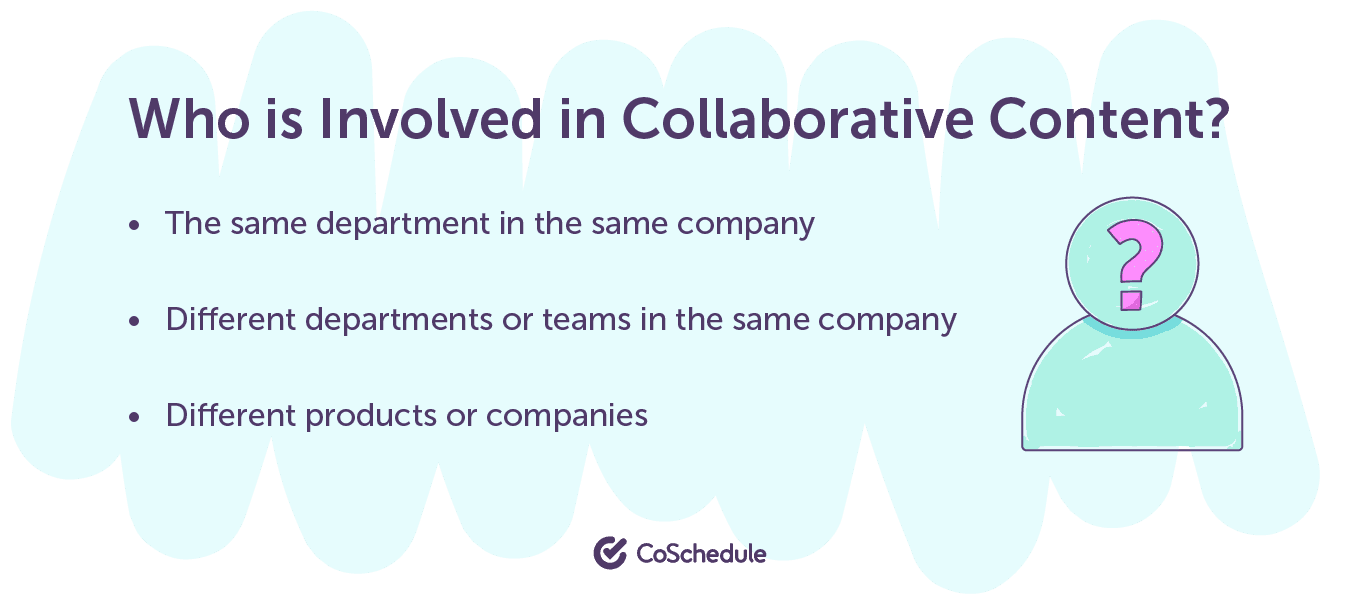 For example, your marketing team could team up with the customer support department for a collaborative blog post, or maybe two video producers from different companies might come together to host a webinar series or online conference.
There are also multiple ways to organize projects.
The collaborative aspects can be spread out throughout the entire process — like a joint-written and promoted ebook — or focused specifically on one part of the overall process — like a team of promoters for a campaign launch.
As you can see, content collaborations are flexible. You can organize and structure it in whichever ways best fit collaborators' goals.
For example, your marketing team could team up with the customer support department for a collaborative blog post, or maybe two video producers from different companies might come together to host a webinar series or online conference.
There are also multiple ways to organize projects.
The collaborative aspects can be spread out throughout the entire process — like a joint-written and promoted ebook — or focused specifically on one part of the overall process — like a team of promoters for a campaign launch.
As you can see, content collaborations are flexible. You can organize and structure it in whichever ways best fit collaborators' goals.
What Are the Benefits of Content Collaborations?
If you've ever carried the workload of a group project, you may be skeptical about this process. Teamwork can be complicated or — when done poorly — ineffective. When it’s done right:- There are more people to share the workload, which isn't necessarily larger than a solo project of the same caliber.
- More people are in the room to bring unique perspectives, experiences, stories, and ideas to the content.
- Having multiple stakeholders from your company invested in the project gives it a stronger defense against internal politics that can delay important work.
- Having multiple stakeholders from multiple companies, each with their own customer base and audience, gives the collaborative content exponentially more visibility than non-collaborative content.
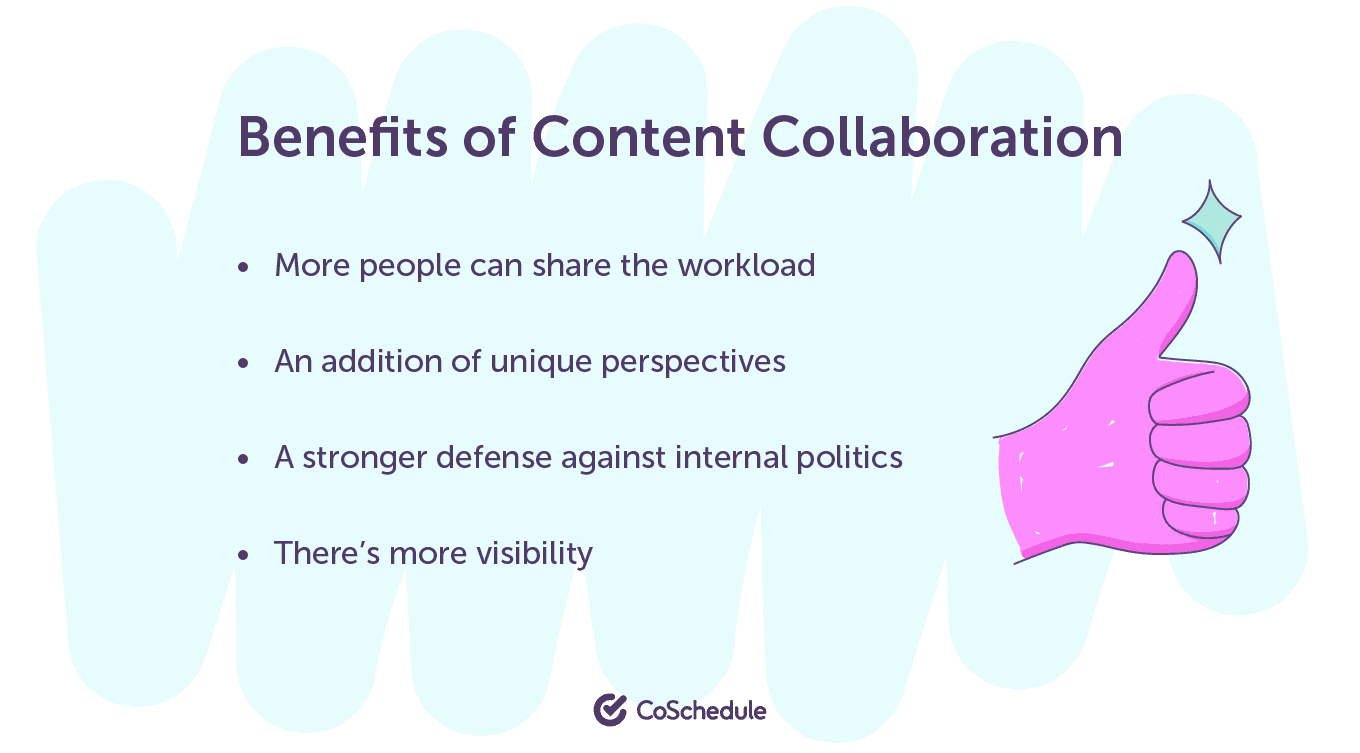 It can ultimately give you much greater results with less work per person than your typical marketing project.
Hopefully, you’re not feeling as skeptical now.
It can ultimately give you much greater results with less work per person than your typical marketing project.
Hopefully, you’re not feeling as skeptical now.
Content Collaboration Tools and Platforms
You're finally ready to start collaborating with other people on content more. Now, consider where your upcoming content collaboration will happen. Consider these tools for managing collaborative projects and content:CoSchedule
Of course, we'll suggest our own tool first. CoSchedule has all the features you would need to manage collaborative projects between multiple people and teams. Since it's built specifically with marketing and content in mind, everything from the integrated tools to view filters and default project types is catered towards the exact type of projects you're going to be working on.Trello
Another option to consider is Trello, a Kanban (column- or board-focused) tool with a simple and easy-to-learn interface. This simplicity can make it convenient for adding collaborators and getting small or simple projects set up quickly. However, it may become unwieldy for larger or longer-term projects.Basecamp
Basecamp is a popular all-in-one project management and communication tool — specifically for remote-first teams. If that's your company, you might already be using Basecamp. It makes perfect sense to use it for content collaborations, too. The rest of your company already knows how to use it, and there's no extra cost to add collaborators from external organizations.Asana
Asana is another popular tool your non-marketing collaborators might already be familiar with. If your organization already uses it, you can create a team or project for your content collaboration and add any external collaborators as guests.Wrike
Our final suggestion is Wrike, an enterprise work management platform. If your team already uses this tool and it's customized to your goals and workflows, you can add an area for your collaborations.What Does Collaborative Content Actually Look Like?
Now that you've got a place to store and manage your collaboration ideas, let's look at what these types of project might look like:Guest Posts
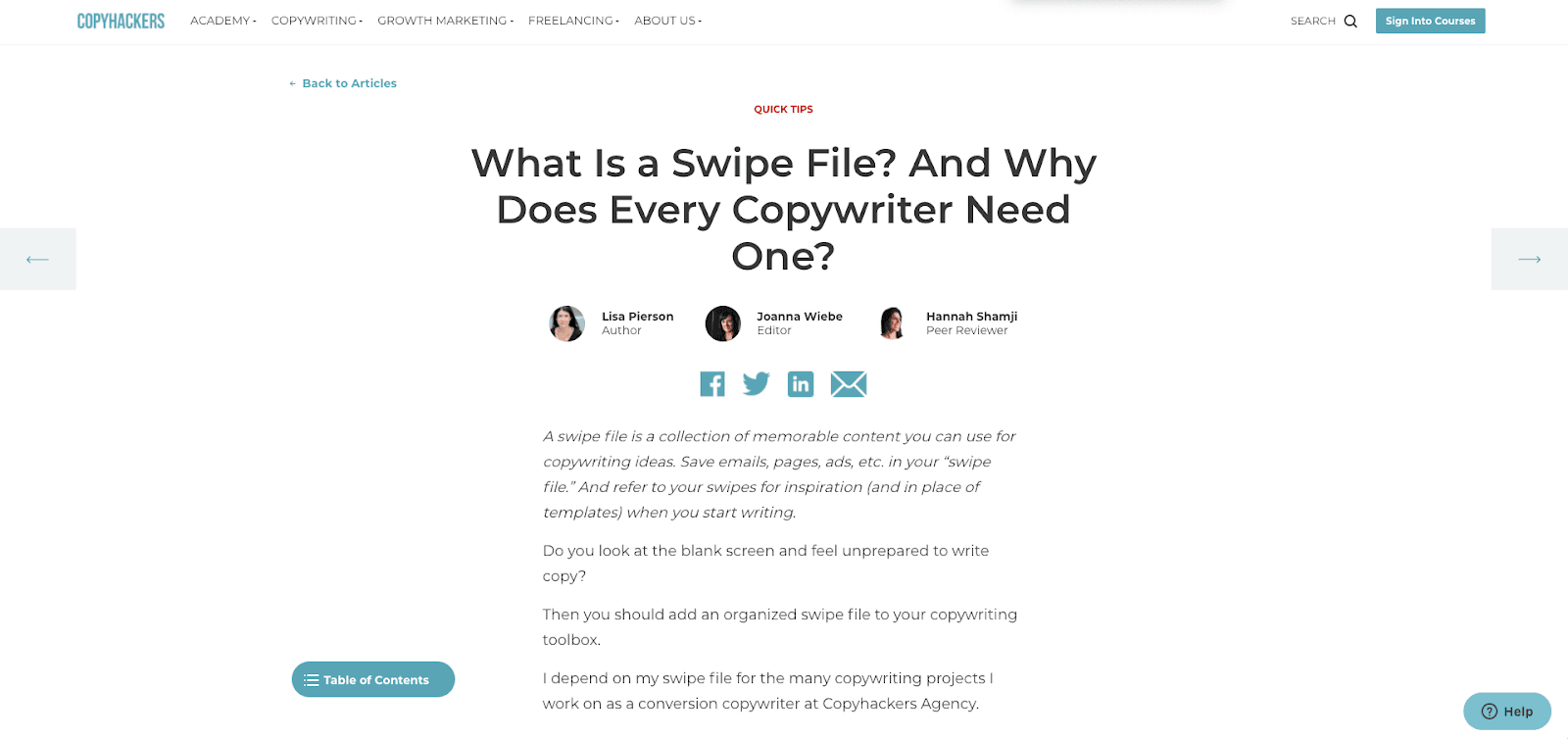 CopyHackers
Guest blogging might be the most common form of collaborative content — for good reason. When you run a blog, you're always looking for more content and fresh perspectives. Publishing guest writers brings both, and if you're a content marketer looking to tap into someone else's audience, writing a guest post is a simple but effective way to do that.
CopyHackers
Guest blogging might be the most common form of collaborative content — for good reason. When you run a blog, you're always looking for more content and fresh perspectives. Publishing guest writers brings both, and if you're a content marketer looking to tap into someone else's audience, writing a guest post is a simple but effective way to do that.
Expert Quote Roundups
Expert quote roundups are another content marketing classic — where you approach multiple subject matter experts for their advice on a single topic or closely-related ones. Roundups are a great way to offer multiple perspectives or possible answers to the same problem. Your roundup can feature a select few experts with longer/multiple quotes or a curation of contributors with more edited quotes. This is a great option if you're looking for something that's low effort for collaborators. You'll do most of the organization for the project and they will contribute a quote and help promote it. Consider it if you're worried about how much time your dream collaborators have.Roundups are a great way to offer multiple perspectives or possible answers to the same problem.
Click To TweetJoint Research Projects
Conducting original research and data analysis is one of the highest value activities you can do for your content marketing. BackLinko
It gives you a unique perspective no one else may have, which makes it as valuable to other content producers and marketers as it is to your ideal customers — making it great link bait.
However, not every content team has the internal resources for conducting, analyzing, and presenting original research. This makes it a perfect collaboration idea for two businesses that would've been unable to conduct the research otherwise.
BackLinko
It gives you a unique perspective no one else may have, which makes it as valuable to other content producers and marketers as it is to your ideal customers — making it great link bait.
However, not every content team has the internal resources for conducting, analyzing, and presenting original research. This makes it a perfect collaboration idea for two businesses that would've been unable to conduct the research otherwise.
Interviews
Similar to expert quote roundups, interviews are a great collaboration for anyone who wants to work with extremely busy partners. All you need to ask for is 30–60 minutes of their time, and then you can do with the content as you please. It can turn into a podcast, a video series on YouTube, an online summit, or whatever you can think of.Podcast Guest Swaps
Speaking of podcasts, another content collaboration for podcasters is a guest swap. Podcasts are still a fairly niche content format, which makes them unique for promoting and growing an audience. It can be a challenge to find people who aren't just your ideal audience, but also interested in audio content. A great way around this is to find other podcasters growing audiences of that kind and trading features or episodes with each other. Even large podcast networks, like NPR and Wondery, have their own versions of this tactic — using larger shows to promote smaller ones.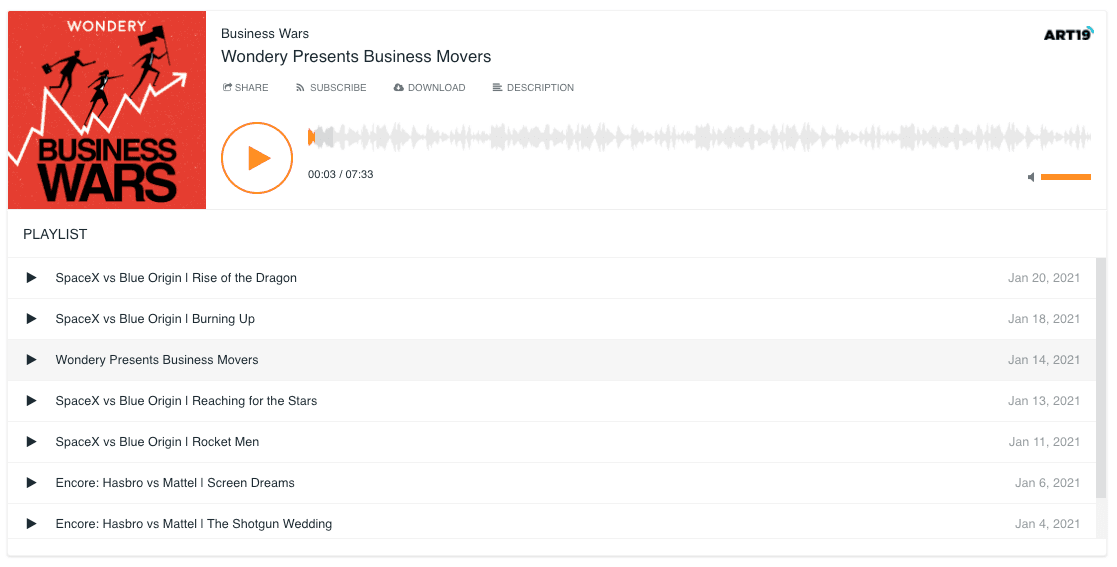 Wondery
Wondery
Giveaways and Contests
Hosting a giveaway or contest in collaboration with another brand — whether that's through email, social media, or a landing page — is another way multiple brands can team up and share each others' audiences. This can be organized in several ways, which allows for multiple levels of involvement from content collaborators. For example, you could co-host and share duties equally or ask collaborators for a donated prize but minimal other involvement.Social Media Takeovers
If your marketing goals specifically include growing your audience on a particular social media channel, consider working with other accounts on social media takeovers. Whether you're featuring industry influencers on your own account or "taking over" a related business's account, it's a way to engage a whole new group of people directly on the platform you're looking to grow.Case Studies
Finally, you can use case studies to feature the work and results of customers and peers that your audience can learn from. Since case studies can be produced based on interviews, it's another excellent option for scenarios where you're looking to ask for minimal time from collaborators.How to Identify and Secure Content Collaboration Partners
Alright! You've got some ideas and you're excited to get started, but don't start reaching out to collaborators just yet. A successful content collaboration requires alignment between the collaborators and the content, so think about that first.
Identifying Potential Collaborators
The first step of choosing a content collaboration is thinking about who you'll be partnering on the project with. Will you be bringing in other teams from your organization, subject matter experts and influencers from multiple brands, or partnering closely with one complementary company?Establishing Goals and Ideas
Deciding what kind of partners you want to collaborate with also requires thinking about what your goals for the collaboration are in the first place. Think about your current goals, what else you're working on, and who will be responsible for executing different parts of the project. Partnering with one company for a research project is ideal for different scenarios than having to interview a series of experts.Partnering with one company for a research project is ideal for different scenarios than having to interview a series of experts.
Click To TweetHow to Execute Collaborative Content
Once you've established a rough idea and landed at least one collaborator, here's how you can put your idea into action.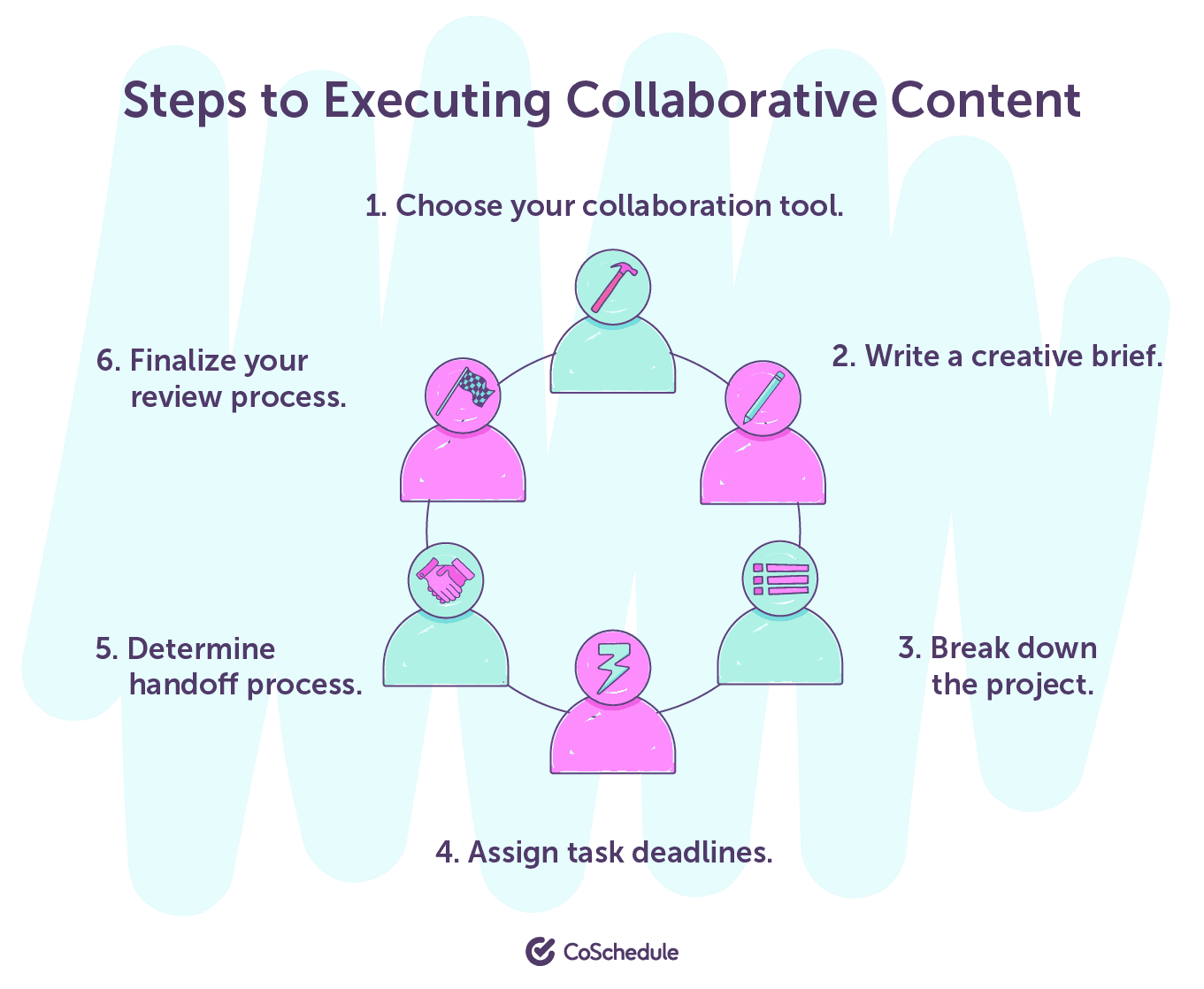
Step 1: Choose Your Collaboration Tool
Before anything else, decide what tool you're using to organize the project. Every other step will include creating assets and deliverables and having conversations. You'll want to have a place to store all that from the very start.Step 2: Write a Creative Brief
One legitimate concern with group work is keeping everyone on the same page throughout the entire project. A creative brief will do wonders for accomplishing that. A good brief outlines the most important information for a project, like the project scope, requirement, goals, and more. With all those details consolidated in one place, you'll be able to prevent future confusion, miscommunication, or missing project parts.Step 3: Break Down the Project
Inside your collaboration tool, braindump or list out all the tasks that you and your collaborators need to complete. The more detailed you get now, the less explaining and scrambling you'll need to do later. Once you've listed everything out, reorder them, so they're displayed in the order in which you'll need to do them. For example, scheduling social media promotion should come after finalizing the collaboration announcement to ensure the promotional content is based on the most up-to-date version of your announcement.Step 4: Assign Task Deadlines
Once you have a full view of the tasks required, estimate how long each will take to complete. Then, you can start assigning each task a deadline based on those times commitments and the collaboration launch date.Step 5: Determine Handoff Processes
The more people involved in a project, the more "handoffs" there are, during which someone can drop the ball. To prevent this, agree on these handoff processes beforehand, including who's in charge of reviewing and approving each one and where this will be communicated.Step 6: Finalize Your Review Process
Speaking of review and approval, in addition to determining the review process for individual assets, you'll want to do the same for the overall project. The whole doesn't always look the same as the sum of its parts, so it needs to be someone's job to ensure there's no misalignment and the creative brief is fulfilled.It needs to be someone's job to ensure there's no misalignment and the creative brief is fulfilled.
Click To Tweet

